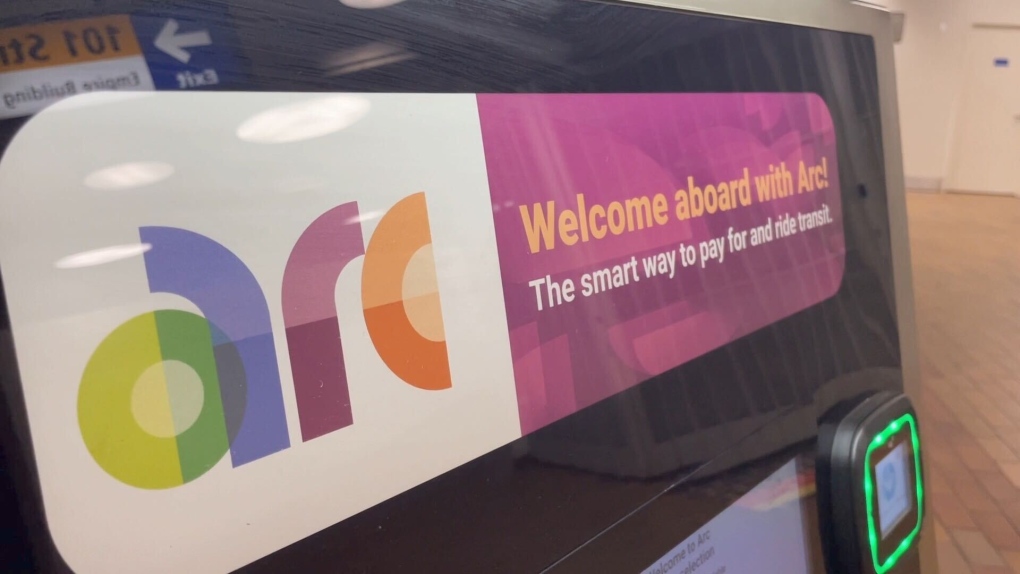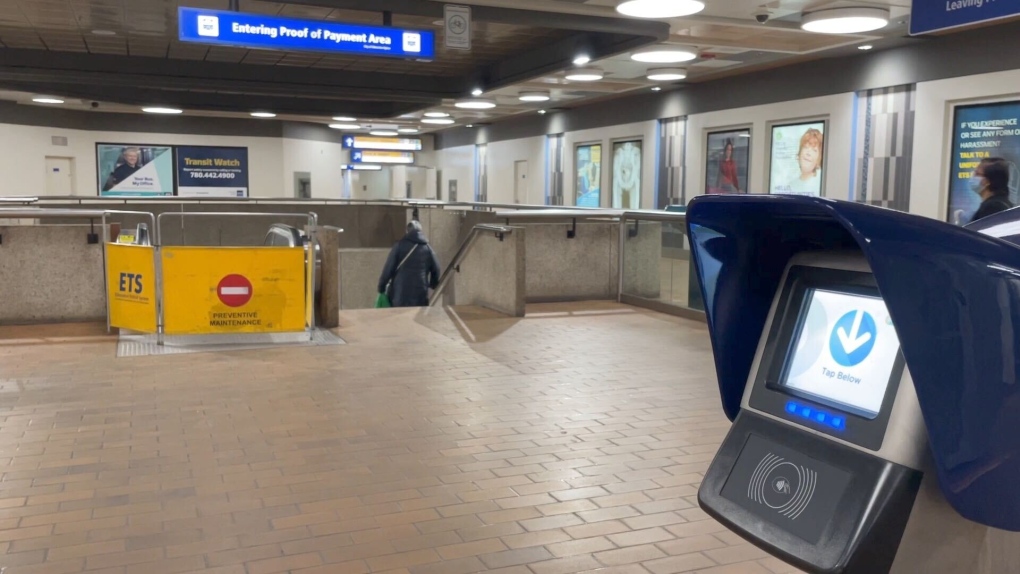Reloadable electronic pre-paid cards to launch at Edmonton transit stations next week
 Arc fare payment system at an Edmonton LRT station on Nov. 15, 2022 (Jeremy Thompson/CTV News Edmonton)
Arc fare payment system at an Edmonton LRT station on Nov. 15, 2022 (Jeremy Thompson/CTV News Edmonton)
Starting Nov. 21, standard adult transit users will transition to the Arc electronic fare payment system across the Edmonton region.
The Arc system means transit users can pay their fare without carrying exact change or using paper tickets and passes.
An Arc card is like a credit card where users can pre-load and reload money to cover their fares.
“Riders who register their ARC accounts also get balance protection and the option to auto-reload their card,” said Carrie Hutton-MacDonald, ETS branch manager.
“Balance protection comes in handy if an ARC card is lost or stolen. So in those instances, we can block the card and then transfer the money balance to a replacement card for them.”
The Arc ticket acts as a temporary card.
“Depending on the pass they purchase, they are valid for unlimited trips for 90 minutes or for 24 hours for local commuter or regional service,” said Hutton-MacDonald.
Cards can be obtained online, at Arc fare vending machines located at transit and LRT stations, at in-person service centres and select retailers.
 Arc fare payment system at an Edmonton LRT station on Nov. 15, 2022 (Jeremy Thompson/CTV News Edmonton)
Arc fare payment system at an Edmonton LRT station on Nov. 15, 2022 (Jeremy Thompson/CTV News Edmonton)
Hutton-Macdonald said the Edmonton region is also the first in Canada to offer regional fare capping, meaning riders pay a per-ride price until they reach a daily or monthly cap.
“So, for example, in Edmonton, the daily cap is $10.25 and the monthly cap is $100. Once that cap is reached the rider rides for free for the rest of the day or month across the region,” she said.
“The per-ride price that standard adult fare riders will pay for a single 90-minute fare is $2.75 instead of the cash fare price of $3.50, so this price point is equivalent to our 10-pack of adult tickets,” she added.
That change will save frequent transit riders and those who make multiple trips a day money, Hutton MacDonald said
“With pay-as-you-go, the really great feature supporting equity and reducing some barriers is you can literally load your card in any increment that you wish," she said. "Instead of having to pay, lets say, $100 for a monthly pass towards the end of the month for the next month, I could decide to do it in increments of $20 if I so choose,” she said.
The Arc system was piloted by U-Pass users as well as hundreds of standard adult transit users in Edmonton, Leduc, Beaumont, Fort Saskatchewan, Strathcona County, Spruce Grove and St. Albert.
“We have seven different partners working together to implement this within the Edmonton metro region. We all have our own fare policies and structures and processes that needed to be integrated into this project,” said Hutton-MacDonald.
“We’re excited to be part of this project. A project that will see passengers in the Edmonton region be able to pay for the rides in new and innovative ways,” said Wade Coombs, Strathcona County Transit director.
 Arc fare payment system at an Edmonton LRT station on Nov. 15, 2022 (Jeremy Thompson/CTV News Edmonton)
Arc fare payment system at an Edmonton LRT station on Nov. 15, 2022 (Jeremy Thompson/CTV News Edmonton)
To use the new cards, transit users will have to tap when they get on and off buses, while LRT users will have to tap when they enter and exit the fare paid zones.
“There are handheld validators that our transit peace officers will have that can scan the Arc ticket or Arc card and then verify if you have in fact paid your fare and tapped on for your trip,” said Hutton-MacDonald.
Those in the discounted fare groups, youth, seniors and low-income users won’t transition to the new system until 2023.
There is also no timeline set for when paper fare products will be phased out.
CTVNews.ca Top Stories

Poilievre writes to GG calling for House recall, confidence vote after Singh declares he's ready to bring Liberals down
Conservative Leader Pierre Poilievre has written to Gov. Gen. Mary Simon, imploring her to 'use your authority to inform the prime minister that he must' recall the House of Commons so a non-confidence vote can be held. This move comes in light of NDP Leader Jagmeet Singh publishing a letter stating his caucus 'will vote to bring this government down' sometime in 2025.
At least 2 dead and 60 hurt after a car drives into a German Christmas market in a suspected attack
A car plowed into a busy outdoor Christmas market in the eastern German city of Magdeburg on Friday, killing at least two people and injuring at least 60 others in what authorities suspect was an attack.
Judge sentences Quebecer convicted of triple murder who shows 'no remorse'
A Quebecer convicted in a triple murder on Montreal's South Shore has been sentenced to life in prison without chance of parole for 20 years in the second-degree death of Synthia Bussieres.
'I understand there's going to be a short runway,' new minister says after Trudeau shuffles cabinet
Prime Minister Justin Trudeau added eight Liberal MPs to his front bench and reassigned four ministers in a cabinet shuffle in Ottawa on Friday, but as soon as they were sworn-in, they faced questions about the political future of their government, and their leader.
U.S. House approves funding bill and sends to Senate hours before government shutdown deadline
Hours to go before a midnight government shutdown, the House has approved a new plan from House Speaker Mike Johnson.
Poilievre to Trump: 'Canada will never be the 51st state'
Conservative leader Pierre Poilievre is responding to U.S. president-elect Donald Trump’s ongoing suggestions that Canada become the 51st state, saying it will 'never happen.'
A new book about Chrystia Freeland just came out. Here's what we learned
A new book about Chrystia Freeland has just come out, after the publishing company sped up its release date by a few months. CTV News sifted through the book and pulled out some notable anecdotes, as well as insights about Freeland's relationship with the prime minister.
Fake nurse Brigitte Cleroux sentenced for B.C. crimes
A woman who impersonated nurses in several provinces has been sentenced to seven years in prison for offences in British Columbia – where she illegally treated nearly 1,000 patients across multiple communities.
Toronto officials warn of possible measles exposure at Pearson airport
Toronto Public Health (TPH) is advising of another possible measles exposure at Canada’s largest airport.
































